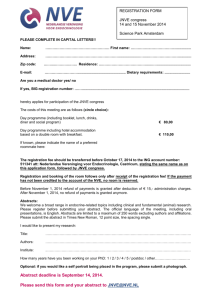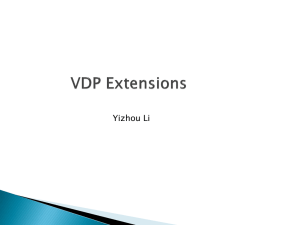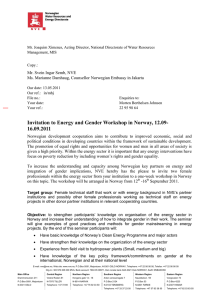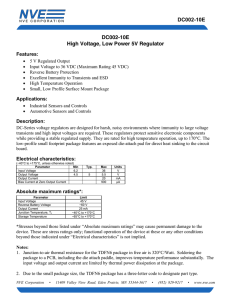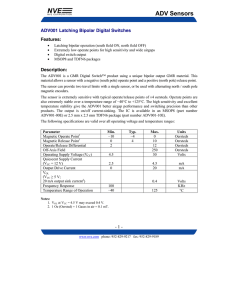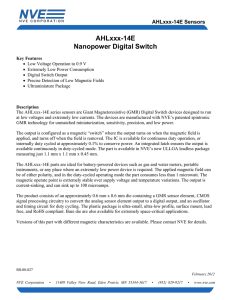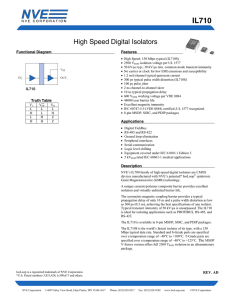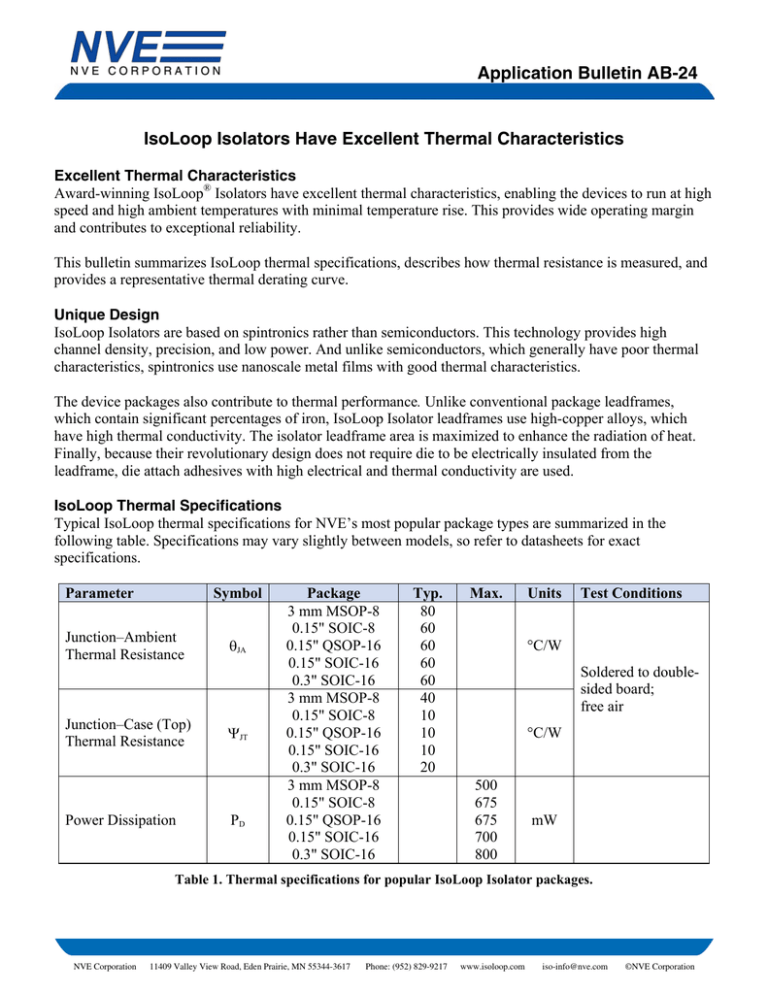
Application Bulletin AB-24
IsoLoop Isolators Have Excellent Thermal Characteristics
Excellent Thermal Characteristics
Award-winning IsoLoop® Isolators have excellent thermal characteristics, enabling the devices to run at high
speed and high ambient temperatures with minimal temperature rise. This provides wide operating margin
and contributes to exceptional reliability.
This bulletin summarizes IsoLoop thermal specifications, describes how thermal resistance is measured, and
provides a representative thermal derating curve.
Unique Design
IsoLoop Isolators are based on spintronics rather than semiconductors. This technology provides high
channel density, precision, and low power. And unlike semiconductors, which generally have poor thermal
characteristics, spintronics use nanoscale metal films with good thermal characteristics.
The device packages also contribute to thermal performance. Unlike conventional package leadframes,
which contain significant percentages of iron, IsoLoop Isolator leadframes use high-copper alloys, which
have high thermal conductivity. The isolator leadframe area is maximized to enhance the radiation of heat.
Finally, because their revolutionary design does not require die to be electrically insulated from the
leadframe, die attach adhesives with high electrical and thermal conductivity are used.
IsoLoop Thermal Specifications
Typical IsoLoop thermal specifications for NVE’s most popular package types are summarized in the
following table. Specifications may vary slightly between models, so refer to datasheets for exact
specifications.
Parameter
Symbol
Junction–Ambient
Thermal Resistance
Junction–Case (Top)
Thermal Resistance
Power Dissipation
θJA
ΨJT
PD
Package
3 mm MSOP-8
0.15" SOIC-8
0.15" QSOP-16
0.15" SOIC-16
0.3" SOIC-16
3 mm MSOP-8
0.15" SOIC-8
0.15" QSOP-16
0.15" SOIC-16
0.3" SOIC-16
3 mm MSOP-8
0.15" SOIC-8
0.15" QSOP-16
0.15" SOIC-16
0.3" SOIC-16
Typ.
80
60
60
60
60
40
10
10
10
20
Max.
Units
Test Conditions
°C/W
Soldered to doublesided board;
free air
°C/W
500
675
675
700
800
mW
Table 1. Thermal specifications for popular IsoLoop Isolator packages.
NVE Corporation
11409 Valley View Road, Eden Prairie, MN 55344-3617
Phone: (952) 829-9217
www.isoloop.com
iso-info@nve.com
©NVE Corporation
Application Bulletin AB-24
Terms and Symbols
Thermal-related terms and symbols are illustrated as follows:
TA
Die
θTA
TCT
ψJT
θJA
TJ
Leadframe
Fig. 1. Thermal-related terms and symbols.
Junction-to-ambient and junction-to-case thermal resistances are calculated as follows:
θJA ≡ (TJ – TA)/PD ;
ΨJT ≡ (TJ – TCT)/PD
Where:
θJA is the junction-to-ambient thermal resistance;
ΨJT is thermal resistance from the junction to the top-center of the case
(“Ψ” is used rather than “θ” to indicate thermal resistance to the top of the package);
TJ is the device die or junction temperature;
TA is ambient temperature;
TCT is the surface temperature of the center-top of the package; and
PD is the total package power dissipation.
Measuring Thermal Resistance
Temperature at the top of the case can be measured with a low thermal mass thermocouple or a noncontact
infrared thermometer. Measuring junction temperature, however, requires some finesse. One method is to
use one of the devices’ input protection diodes as a temperature sensor, taking advantage of the linear
relationship between absolute temperature and the forward voltage drops of a diode with a constant-current
bias. The input is reversed biased using the diode-test function of a multimeter or constant-current source
measure unit as shown in Figure 2:
2
NVE Corporation
11409 Valley View Road, Eden Prairie, MN 55344-3617
Phone: (952) 829-9217
www.isoloop.com
iso-info@nve.com
©NVE Corporation
Application Bulletin AB-24
VDD
PD = I DD x V DD
Source
Measure
Unit
VF
Device
Under Test
Fig. 2. Measuring thermal resistance.
VF versus temperature is characterized in an environmental chamber at several temperatures to generate a
temperature calibration curve.
Total supply current is monitored to calculate package power dissipation. Power dissipation in the Device
Under Test can be varied by changing input speeds, number of active channels, and output loading.
Thermal Resistance of Different Packages
The specifications in Table 1 show that the junction–ambient thermal resistances for SOIC-8, QSOP-16,
narrow-body SOIC-16, and wide-body SOIC-16 packages are similar. This is because higher case-toambient thermal resistance in the smaller packages is offset by lower junction–case thermal resistances since
they are thinner and have relatively large leadframe areas. This convenient coincidence allows one derating
curve for four package types (MSOP packages have higher junction–ambient thermal resistances).
Derating Curves
IL200/IL700-Series Isolators have very low quiescent power consumption, but like most electronic devices,
power consumption increases with operating frequency. Because of the high speed and channel density of
these isolators, temperature rise should be considered when running multiple channels at high speed. Power
consumption is higher at 5 volt operation than at 3.3 volts, and dynamic supply current is higher on the input
side of the isolators than the output side, so thermal management can be especially important with five-volt
input- side power supplies.
The derating curve for IIL200- and IL700-Series Isolators at several typical operating temperatures is as
illustrated in Figure 3:
3
NVE Corporation
11409 Valley View Road, Eden Prairie, MN 55344-3617
Phone: (952) 829-9217
www.isoloop.com
iso-info@nve.com
©NVE Corporation
Application Bulletin AB-24
Fig. 3. IL200/IL700-Series Isolator derating curve
(SOIC-8, QSOP-16, narrow-body SOIC-16, or wide-body SOIC-16).
Conclusion—Heat Isn’t a Hot Issue With IsoLoops
In most applications thermal performance is not an issue. Standard-grade IL200/IL700-Series Isolators have
a maximum junction temperature of 110°C. “T-Grade” parts have a maximum operating junction
temperature of 125°C for additional margin at extreme operating conditions.
The IL200/IL700-Series Isolators were used for illustration. IL500-Series Isolators are similar, although
quiescent currents are slightly higher because they have “refresh” circuitry. Digital-input isolated RS-485,
RS-422, and CAN transceivers have higher quiescent currents from the transceiver functions. IL600-Series
passive-input isolators and passive-input isolated transceivers have higher quiescent current but less dynamic
power consumption because they are level sensitive, rather than edge sensitive.
4
NVE Corporation
11409 Valley View Road, Eden Prairie, MN 55344-3617
Phone: (952) 829-9217
www.isoloop.com
iso-info@nve.com
©NVE Corporation
Application Bulletin AB-24
Limited Warranty and Liability
Information in this document is believed to be accurate and reliable. However, NVE does not give any representations or warranties, expressed or
implied, as to the accuracy or completeness of such information and shall have no liability for the consequences of use of such information.
In no event shall NVE be liable for any indirect, incidental, punitive, special or consequential damages (including, without limitation, lost profits,
lost savings, business interruption, costs related to the removal or replacement of any products or rework charges) whether or not such damages
are based on tort (including negligence), warranty, breach of contract or any other legal theory.
Right to Make Changes
NVE reserves the right to make changes to information published in this document including, without limitation, specifications and product
descriptions at any time and without notice. This document supersedes and replaces all information supplied prior to its publication.
Use in Life-Critical or Safety-Critical Applications
Unless NVE and a customer explicitly agree otherwise in writing, NVE products are not designed, authorized or warranted to be suitable for use
in life support, life-critical or safety-critical devices or equipment. NVE accepts no liability for inclusion or use of NVE products in such
applications and such inclusion or use is at the customer’s own risk. Should the customer use NVE products for such application whether
authorized by NVE or not, the customer shall indemnify and hold NVE harmless against all claims and damages.
Applications
Applications described in this datasheet are illustrative only. NVE makes no representation or warranty that such applications will be suitable for
the specified use without further testing or modification.
Customers are responsible for the design and operation of their applications and products using NVE products, and NVE accepts no liability for
any assistance with applications or customer product design. It is customer’s sole responsibility to determine whether the NVE product is suitable
and fit for the customer’s applications and products planned, as well as for the planned application and use of customer’s third party customers.
Customers should provide appropriate design and operating safeguards to minimize the risks associated with their applications and products.
NVE does not accept any liability related to any default, damage, costs or problem which is based on any weakness or default in the customer’s
applications or products, or the application or use by customer’s third party customers. The customer is responsible for all necessary testing for
the customer’s applications and products using NVE products in order to avoid a default of the applications and the products or of the application
or use by customer’s third party customers. NVE accepts no liability in this respect.
Limiting Values
Stress above one or more limiting values (as defined in the Absolute Maximum Ratings System of IEC 60134) will cause permanent damage to
the device. Limiting values are stress ratings only and operation of the device at these or any other conditions above those given in the
recommended operating conditions of the datasheet is not warranted. Constant or repeated exposure to limiting values will permanently and
irreversibly affect the quality and reliability of the device.
Terms and Conditions of Sale
In case an individual agreement is concluded only the terms and conditions of the respective agreement shall apply. NVE hereby expressly
objects to applying the customer’s general terms and conditions with regard to the purchase of NVE products by customer.
No Offer to Sell or License
Nothing in this document may be interpreted or construed as an offer to sell products that is open for acceptance or the grant, conveyance or
implication of any license under any copyrights, patents or other industrial or intellectual property rights.
Export Control
This document as well as the items described herein may be subject to export control regulations. Export might require a prior authorization from
national authorities.
Automotive Qualified Products
Unless the datasheet expressly states that a specific NVE product is automotive qualified, the product is not suitable for automotive use. It is
neither qualified nor tested in accordance with automotive testing or application requirements. NVE accepts no liability for inclusion or use of
non-automotive qualified products in automotive equipment or applications.
In the event that customer uses the product for design-in and use in automotive applications to automotive specifications and standards, customer
(a) shall use the product without NVE’s warranty of the product for such automotive applications, use and specifications, and (b) whenever
customer uses the product for automotive applications beyond NVE’s specifications such use shall be solely at customer’s own risk, and
(c) customer fully indemnifies NVE for any liability, damages or failed product claims resulting from customer design and use of the product for
automotive applications beyond NVE’s standard warranty and NVE’s product specifications.
5
NVE Corporation
11409 Valley View Road, Eden Prairie, MN 55344-3617
Phone: (952) 829-9217
www.isoloop.com
iso-info@nve.com
©NVE Corporation
Application Bulletin AB-24
An ISO 9001 Certified Company
NVE Corporation
11409 Valley View Road
Eden Prairie, MN 55344-3617 USA
Telephone: (952) 829-9217
Fax: (952) 829-9189
www.nve.com
e-mail: iso-info@nve.com
©NVE Corporation
All rights are reserved. Reproduction in whole or in part is prohibited without the prior written consent of the copyright owner.
ISB-AP-24
January 2014
6
NVE Corporation
11409 Valley View Road, Eden Prairie, MN 55344-3617
Phone: (952) 829-9217
www.isoloop.com
iso-info@nve.com
©NVE Corporation

